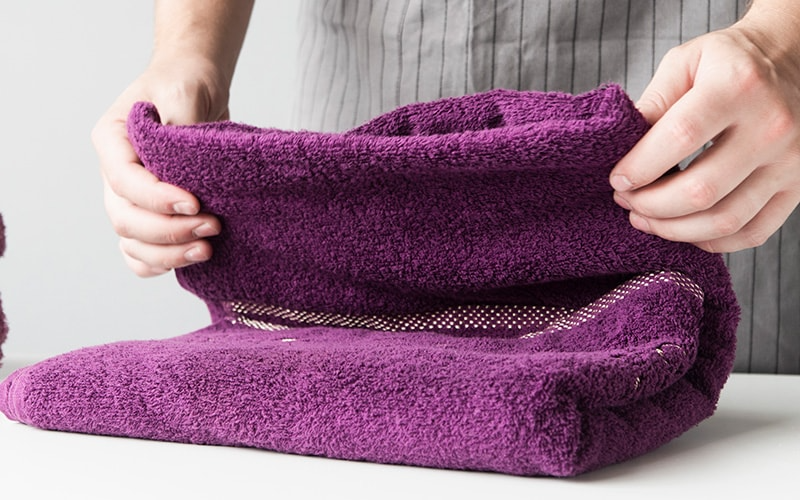A high-quality microfiber towel is more than just a cleaning cloth. It’s a tool designed for superior performance, durability, and care of delicate surfaces. Unlike ordinary towels, premium microfiber offers ultra-fine fibers that lift dirt, absorb moisture, and give you a streak-free finish without leaving a scratch.
In this article, we’ll explore factors that make a microfiber towel truly high quality and share tips for choosing the right one for your needs.
4 Ways to Check the Quality of Microfiber Towels
Here are four key factors that contribute to a high-quality microfiber towel.
1. Fabric Blend Ratio
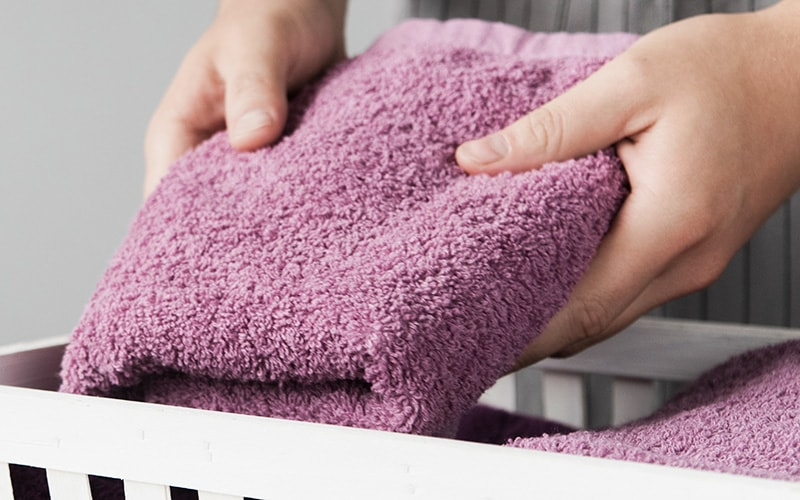
Microfiber cloths are made from a blend of polyester and polyamide (also known as nylon). An 80/20 blend means 80% of the microfiber towel is made from polyester and 20% is nylon.
Polyester provides durability and longevity, but at the cost of softness. In comparison, nylon offers softness and high water absorbency. As nylon is more expensive than polyester, most manufacturers skimp out and reduce the nylon ratio.
Generally speaking, the blend ratio of your microfiber cloth depends on the application.
- Bath Towels: An 80/20 blend for good absorbency and long lifespan.
- Facial Care: A 70/30 for extra softness and gentle cleaning.
- Cleaning Mirrors & Windows: A 90/10 blend is perfectly fine. Glass is hard to scratch, so there’s no need for an ultra-soft towel.
- Kitchen & House Cleaning: An 80/20 blend provides good absorbency.
- Car Washing: A 70/30 microfiber towel will minimize the risk of accidental scratches.
- Electronics Cleaning: A 70/30 microfiber cloth will grab all of the dust and water from the surface without scratching the digital screens.
If you’re still unsure about the blend ratios, we have a quick tip. For microfiber cleaning applications, you need a high polyester ratio for surface scrubbing. For drying applications, you need a high nylon ratio.
2. Towel Density GSM
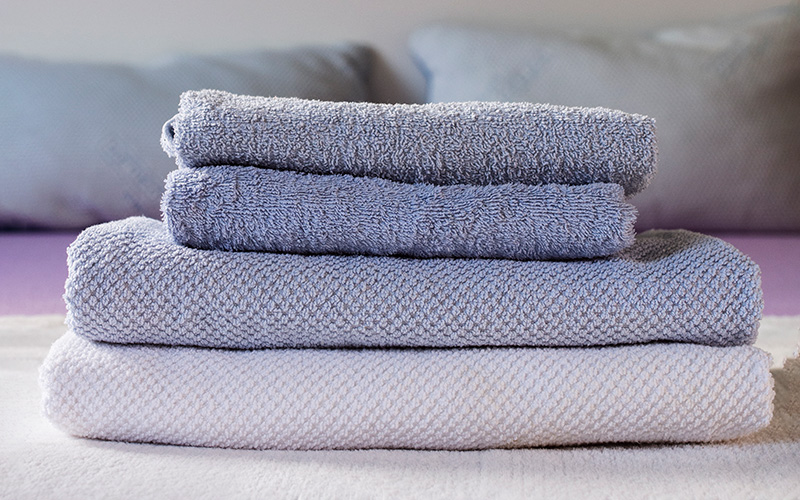
Another quality metric for microfiber towels is their weight or GSM (grams per square meter). Weight can change based on the size of the towel. So, manufacturers use GSM to describe the density of a towel. A high GSM number means higher quality.
GSM is directly related to the amount of material used in towel manufacturing. Meaning GSM will impact the weight of microfiber products and thus their price. Additionally, microfiber cloths with higher GSM have the ability to absorb more water.
However, a heavier towel isn’t always better, and there are many reasons for you to stick with a low GSM towel.
- Phone or Eyewear Cleaning applications need a lightweight 250-300 GSM microfiber cloth that is easy to fold and store in pockets.
- Cleaning Windows doesn’t need a high GSM towel. A 250-300 GSM microfiber towel is good enough.
- Dish Towels should be 300-400GSM. Absorbent enough to dry dishes but not too heavy to handle.
- Body Towels should be 400-600 GSM. A higher GSM towel will be more absorbent, but significantly heavier.
- Polishing cars or other surfaces requires a high 500-600 GSM microfiber towel.
- Car Washing and Drying require a very high GSM towel to absorb the maximum amount of liquid and reduce the risk of water stains. 600-1200 GSM towels will wipe away all dust, debris, and water.
Many brands offer high-quality 1000 GSM towels for car washing applications. It is one of the few applications that need more absorbent fibers. Towels that are less than 200 GSM will be rough, less absorbent, and on the same quality level as paper towels.
3. Weave Type
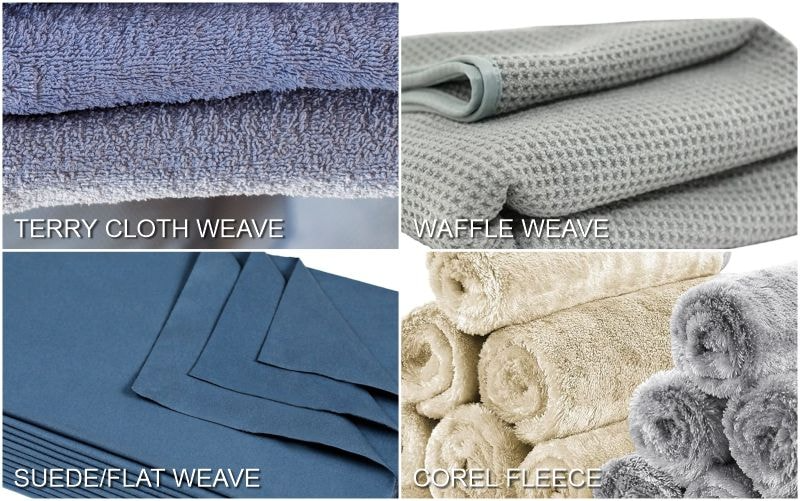
Weaving is a mechanical process that transforms microfiber threads into a soft cloth or towel. The weave type affects the absorbency, softness, and fraying properties of a towel.
Here are the four most commonly used microfiber towel weaves.
- Terry Weave Towels: Most microfiber cloths use a terry weave, which results in standing loops on the surface. The loops catch dust particles and make the towels more absorbent.
- Waffle Weave Towels: This type of weave has a waffle-like pattern. The raised and depressed sections make the towel more absorbent. However, unlike a terry cloth, there is a reduced chance of fraying and loose fibers.
- Suede/Flat Weave Towels: This is a flat weave that results in a super smooth and uniform towel surface. With a flat weave, you don’t have to worry about scratches. Dust and dirt can get caught in terry weaves. Later, those dirt particles get dragged across the cleaning surfaces and result in scratches.
- Coral Fleece Weave Towels: This type of weave results in separated standing threads on microfiber cloths. Coral fleece has a more fluffy and bouncy feel that works great for body and facial care.
Other towel weaves include diamond, pearl, and herringbone weaves. These weaves are similar to a waffle weave and are recommended for polishing or cleaning applications. The main difference between these towels is the manufacturing process, skin feel, and price tag.
4. Edge Stitching
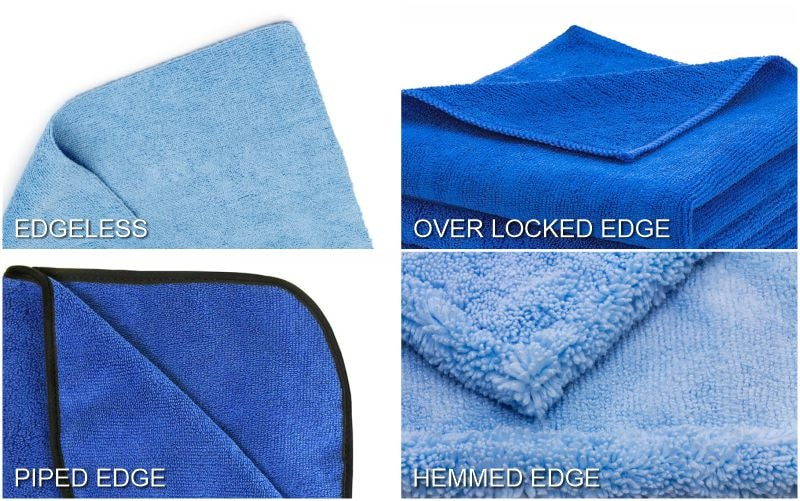
Finally, a good way to determine the quality of a towel is to look at the edge stitching. Edge stitching often requires expensive machinery, so many brands forego the practice. A high-quality towel will have high-quality edge stitching.
Here are the four most common microfiber edge stitching options.
- Edgeless: Towels cut using an ultrasonic machine that seals the edges using heat. As there is no extra thread or material on the edges, it reduces the chances of scratches. However, there is a good chance that the edges will fray over time. These are the best microfiber cloths for buffing and polishing applications. You can get a pack of them for a fairly low price.
- Serged or Overlocked Edge: Serging is the most cost-effective method of edge stitching. It wraps the edges in extra thread to prevent them from fraying. Although it works great, it doesn’t feel premium. You will find this type of stitching in budget microfiber products.
- Piped or Banded Edge: Piped edging stitches strips of cloth across the edges to seal them. It results in softer edges with a more premium feel. Brands often use piped edges to add a contrasting color to the microfiber towel design. Banned edges are the same, except they use a wider strip around the edges.
- Hemmed Edge: A hemmed edge uses folds in the edges of microfiber cleaning towels over itself and stitches them shut. Many brands pass on this edging as it uses more material. Professionals recommend this type of towel edge as it doesn’t scratch surfaces and lasts longer. It works great for car detailing and cleaning video camera lenses.
Low-Quality vs. High-Quality Microfiber Cleaning Towels
Let’s condense everything we have learned so far into an easy-to-understand chart.
Table 1 – Comparing low and high-quality indicators for microfiber towels.
| Attributes | Low-Quality Indicators | High-Quality Indicators |
|---|---|---|
| Material Blend | <15% Nylon | 20-30 % Nylon |
| Grams per Square Meter | <400 GSM | >400 GSM |
| Size | <12x12 inches | >24x24 inches |
| Weave | Terry or Flat | Waffle or Coral Fleece |
| Absorbency | Low-Medium | High |
| Edges | Edgeless or Overlocked | Piped or Hemmed |
| Cost | Low | High |
Remember, these are general indicators of quality, and you should always consider your application and needs when choosing a microfiber cleaning towel.
Choosing the Best Microfiber Towels for Your Home or Business
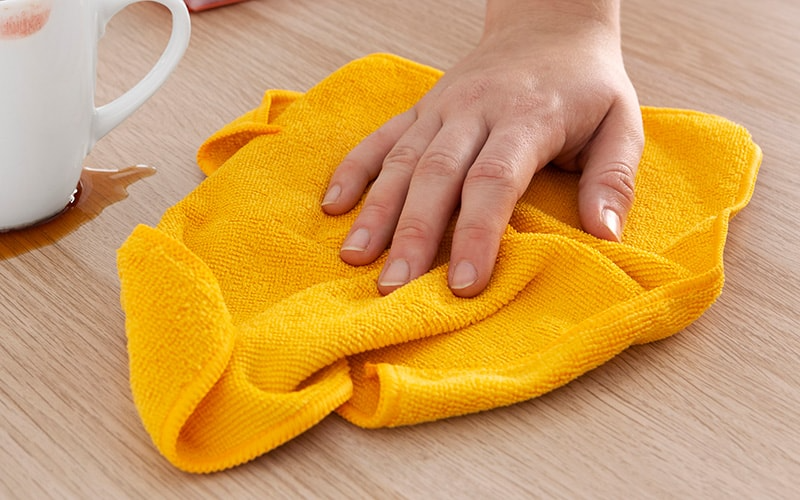
Here are some quick and easy tips to help you pick out the best microfiber towels according to your needs.
1. Material Construction and Softness
Look for the fabric blend to see the nylon percentage. High nylon content results in a softer and more skin-friendly towel. We recommend looking at product reviews to gauge the microfiber towel quality.
2. Absorbency and Water Resistance
A good microfiber towel will absorb and remove all the water spots. Reducing the risk of water stains. Absorbency is indicated by towel weight, weave type, and towel size.
3. Quick Drying
High-quality microfiber towels dry quickly to prevent bacterial growth. You should sun or air-dry your microfiber cloths, as tumble drying can damage the fibers.
4. Cost-Effectiveness
Cost is a direct indicator of quality. But that high cost should be accompanied by a good weave, quality edge stitching, and a high GSM microfiber towel.
5. Recommended Application
Use the quality indicators at the top to determine which microfiber towels are best suited to your desired applications.
Tips for Taking Care of Microfiber Cloths Maintenance
Here are some tips for taking care of your microfiber towels.
- Wash Separately – Keep microfiber cloths away from cotton and other lint-producing fabrics.
- Use Mild Detergent – Avoid harsh chemicals, bleach, and fabric softeners.
- Wash in Cold or Warm Water – Hot water can damage the tiny polyester and nylon fibers.
- Air Dry or Low Heat – Avoid high-heat tumble drying. Hang your microfiber towels to air or sun dry.
- Use Dry Storage – Moisture can result in bacteria and dust accumulation.
- Replace – After 300-500 wash cycles or 1-2 years of use.
Conclusion
The quality of microfiber towels varies based on several factors. Ideally, you should look for towels with a good nylon ratio, high GSM, and decent edge stitching. The easiest testing method is to rub a microfiber towel on your face and judge its softness. Use the information from this article to choose your next microfiber towel.
Get Ultra Soft Premium Quality Microfiber Towels from Manywell!
Manywell is the leading manufacturer and supplier of high-quality cleaning products. We specialize in microfiber cleaning cloths and towels. All our products are 100% customizable. So, you can get the ultimate microfiber towel tailored to your specific needs.
With 17 years of industry experience and over a dozen quality certifications, we have established a reputation as a trustworthy brand. Choose a manufacturer that millions around the world trust.

